Executive Summary
The period December 2008 to January 2009 saw the southern Cape experiencing one of the worst drought periods in living memory. Sedgefield, a seaside town on the Garden Route is situated within the Knysna local municipal area ran out of water due to the failure of its main source of supply, the Karatara River. Sedgefield has a permanent population of 6 000 which doubles in peak season.
Knysna Municipality realized that although conventional storage, treatment and conveyancing structures may meet peak demand, but, when coupled with severe drought conditions, water shortages and rationing occur – with a devastating effect on all aspects of the region's economy.
Knysna Municipality together with consultants SSI a DHV Company developed an innovative, demand-based solution to solve the water supply crisis to Sedgefield which is both economical and took weeks, rather than years, to implement.
Under these critical conditions (in which water was trucked in to Sedgefield), the Knysna Municipality made better use of what is available and to supplement traditional, inexpensive supply sources with ground water , desalinated water and the re-use of final effluent. The conjunctive supply option will limit risk and provide a sustainable supply of potable water for Sedgefield.
An emergency programme was embarked upon to manage and conserve water and to provide a back-up resource to ensure adequate water supply to provide the anticipated water demand that peaks at 3.5Mℓ/day during the holiday periods.
It was agreed to proceed with the following solution to meet the estimated demand of 3.5Mℓ/day:
-
Curtail and guarantee the surface water supply from the Karatara/Hoogekraal Rivers to 1.5Mℓ/day;
-
new groundwater supply of 0.5Mℓ/day; and
-
provide the deficit 1.5Mℓ/day by desalinating.
After implementing the first two steps in the Sedgefield water augmentation plan, a desalination plant had to be erected within severe time and financial constraints.
Having investigated several potentially suitable locations for such a plant – keeping cost and environmental restrictions in mind at all times – it was decided to install a 'mobile' desalination plant adjacent to the parking area at Myoli Beach from where the desalinated water could be pumped to the Blombosnek reservoirs.
Environmental processes (which included specialist impact studies) were run in parallel with emergency regulations and are ongoing. In addition, the bulk electrical supply had to be upgraded to Mayoli Beach.
To meet the long term demand of 4.5Mℓ/day it is proposed to supplement the surface, ground and desalinated water with the re-use of final effluent from the waste water treatment works. The additional 1Mℓ/day will provide for Sedgefield's potable water needs to 2034. The URV values and utilization values of the different water sources is shown in Diagram 1.
This project has proved to be a particularly gratifying one as it is part of an integrated approach: spreading the risk and decreasing the stress on rivers whilst providing a sustainable back-up plan for emergency drought conditions and peak-season water demand.
Below: URV values and utilisation of the available
water sources.
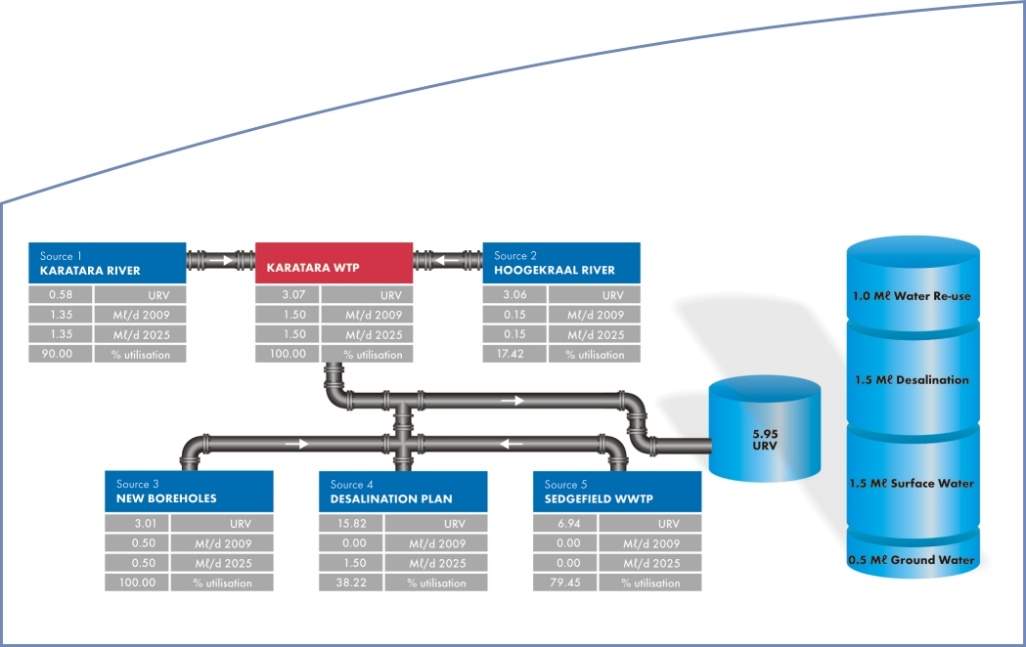
Introduction & Background
The period December 2008 to January 2010 has seen the Southern Cape experiencing one of the worst drought periods ever. Sedgefield, a seaside town on the Garden Route in the southern Cape, situated within the Knysna local municipal area, effectively ran dry in January 2009 when the Karatara River stopped flowing.
While potable water was tankered in to Sedgefield, the Knysna Municipality sought an urgent solution, and alternatives were examined to implement rapid, short and medium term options. The conventional storage, treatment and conveyancing structures may meet peak demand, but these can fail in severe drought conditions, with the resulting water shortages having a devastating effect on all aspects of the local economy.
Existing Water Supply
The town relied on the in-stream flow of the Karatara River to supply water, as there are no dams or impoundments to provide water in the event that the river stops flowing.
Sedgefield Water Augmentation Report 2003
A comprehensive long term plan to provide water for Sedgefield up to the year 2030 was developed and reported on by Ninham Shand Consulting Engineers (May 2003, Sedgefield Water Augmentation Report, Report No.9933/3483).
The plan consisted of abstracting water from the Hoekraal River, storing it in an off-channel dam, down-grading the present Ruigtevlei WTW on the Karatara River to a pumping facility, and constructing a new WTW on the Cloud Nine Hill above Sedgefield town. The total budget in 2008 for the scheme was R110-million (from figures presented in January 2009: “with a URV of R7.60, based on 70% Disaster / MIG project funding and 30% counter-funding from Knysna Municipality”).
The plan was not implemented due to a lack of funds, although some funding (R14.2-million) was obtained, from National Treasury following the August 2006 floods, for relocating the WTW.
Sedgefield Waste Water Treatment Works
The existing WWTW is located on a small site with restricted boundaries, between dunes and existing residential developments. A portion of the discharge flows into the Groenvlei, which is a sensitive water receptor; this has resulted in strict performance criteria being set by DWAF.
The existing SBR units are rated to treat up to 750kℓ/day. The current treatment configuration does not meet the required Special Limit Values, imposed by DWAF. The SLV limits are not met due to high hydraulic loading in peak seasons and the higher than average sewage strength.
The Municipality initiated a study in 2007, to investigate the upgrading options to meet the SLV standards for effluent discharge.
Proposed Sedgefield water augmentation plan
Under crisis conditions in January 2009, it was proposed that certain interventions be implemented immediately to prevent interruptions to the town's water supply. These items were chosen as alternatives to the continued transfer of potable water from George/Wilderness by road tanker (an expensive but effective measure that provided initial relief).
Short term options were also examined for implementation after the initial crisis measures, and these are described below under the Accelerated Water Augmentation Plan.
Subsequently, the investigation was expanded to examine the medium term and longer term options, and to develop an integrated plan for the proposed water supply augmentation measures. This mitigates the risk of overall supply failure, should one, or more, of the sources fail.
The immediate, short, medium and long term supply options now combine the conjunctive use of surface water, ground water, desalinated water and the re-use of final effluent from the waste water treatment works. These sources were ranked based on costs and risk of failure to provide for Sedgefield's long term water needs.
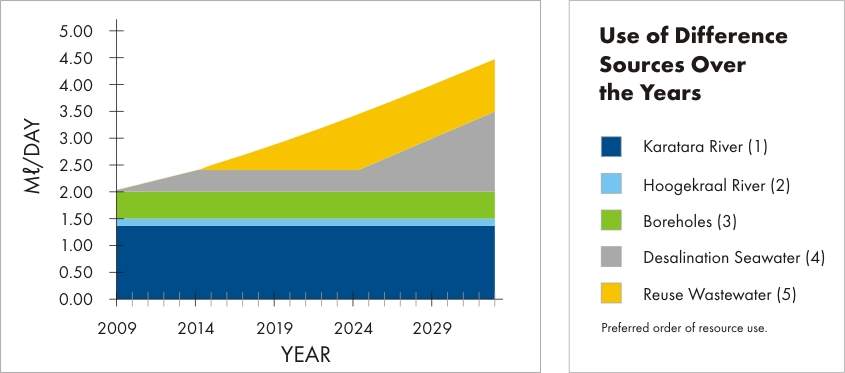
The proposed scheme is be phased to provide water as the demands increase, and, in addition, an important aspect is the ability to provide “insurance” against peak season failure in the short to medium term. At present the peak season demand is 30% higher than the average.
Figure 2, below, shows the distribution of the amounts of water produced from the different sources.
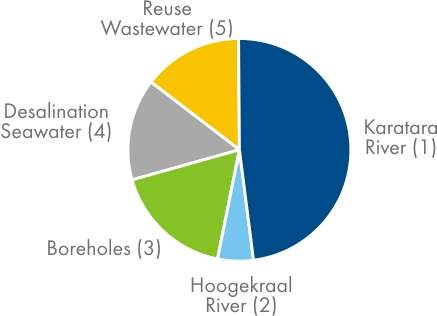
Accelerated water augmentation plan 2009
Hoogekraal River Transfer - Rapid (Complete)
The Hoogekraal River continues to flow throughout the months of December 2008 and January 2009. The catchment area is steep and responds well to precipitation. The level of the Hoogekraal River upstream of the weir is noticeably higher than the level in the Swartvlei and seawater contamination from Swartvlei is highly unlikely.
As a rapid intervention a portable pumpstation and 110mm diameter pipe was installed to pump water from the Hoogekraal River to the Ruigtevlei Water Purification Works on the Karatara River. The pipeline was laid above ground as an interim measure and will be buried in due course.
The pipeline is 3600 meters in length and can deliver approximately 1Mℓ to the Ruigtevlei WTW. The cost to implement the scheme is R1.3-million (Excl VAT).
Well Points – Rapid (Complete)
Existing privately owners well points at Lake Pleasant and Windemere was investigated which could rapidly be brought into production. The yield of the well points is approximately 0,290Mℓ/day.
The cost of equipment and transferring the water into the supply system is R0.4-million (Excl VAT).
Hoogekraal River Transfer Short Term (Complete)
The Hoogekraal transfer scheme must be made permanent by burying the 110mm diameter HDPE pipe, and providing a permanent position and electrical power for the pumps. The estimated cost is R0.5-million (Excl VAT)
Emergency Drilling Program Short Term (Complete)
A number of shallow boreholes were drilled and preliminary test indicative a borehole yield of 1,5Mℓ/day. The aquifer yield has not been accurately determined and for planning purposes only 0,5Mℓ/day is included in the scheme. The cost of the plantation borehole field is R3.0-million (Excl VAT).
Karatara River Weir – Short Term (Initiated)
To prevent further seawater contamination from the Swartvlei into the Karatara River at the Ruigtevlei WTW, temporary weir plates have been placed at the culvert openings.
A permanent installation is however required to prevent further contamination. The estimated cost for this work is R2.5-million (Excl VAT).
Figure 3: Sedgefield Water AugmentationPlan – Layout
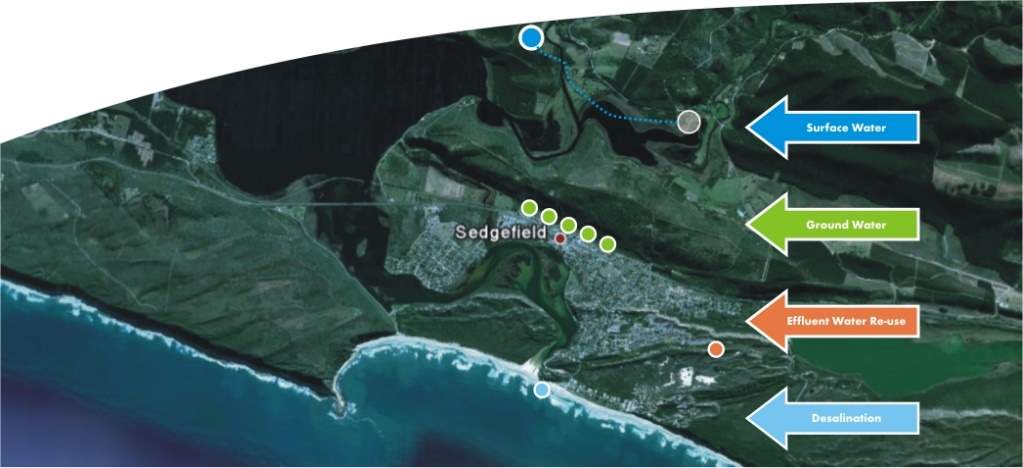
Medium term water augmentation plan
In the short to medium term the following options were examined for implementation as the water demand grows.
Desalination (Complete)
To meet the immediate demand (inclusive of plan period) approximately 3,5Mℓ/day assured supply is required.
The surface water supply from the Karatara /Hoogekraal River should be curtailed at 1,5Mℓ/day and supply from boreholes at 0,5Mℓ/day. The difference is 1,5Mℓ/day will be made up from desalination of seawater.
The Sedgefield desalination plant is a single-pass, reverse osmosis (RO) system that can produce potable water of 1. 5Mℓ/day. The plant consists of two 0.75Mℓ/day modules in two separate 12m steel shipping containers. Extracting seawater and disposing of the concentrate (brine) is achieved by using beach wells. More than twice the amount of seawater is required to produce 1.5Mℓ/day of potable water - with 45% being harvested as product and 55% returned to the sea as concentrate (brine). Initially the plant will be operated by the supplier for one year – which will probably be extended to three or five years.
Knysna Municipality and its team is justifiably proud to have completed this project within three months: the appointment contract was signed on 1 October 2009 and the plant was functional on 18 December 2009, in time for the anticipated holiday peak in December 2009.
A number of potential locations were investigated with extraction of the feed water from the Swartvlei and directly from the sea. Due to time constraints and the need to have the plant ready for the December holiday period the Environmental Processes were conducted in parallel to the procurement of the plant. It was decide to procure a containerized (mobile) plant that could be moved should the environmental process show negative inpact to the surrounds. The cost reflected in the business plan is based on the option placing a mobile plant near to the sea at Myoli Beach's parking area and pumping the desalination product water to the Blombosnek reservoirs to blend in with the water from other sources.
The cost of the plant includes for beach well abstraction points and beach well brine discharge points.
The cost of running the plant will be closely monitored and reported. The estimated operating and maintenance costs are as follows:
Estimated Operating and Maintenance Costs

Notes:
* Based on the plant running 24h/day, producing 1.5Mℓ/day, i.e. lowest unit cost
** R0.50 per kWh assumed due to Eskom tariff increases (2009 power costs were initially R0.30 per kWh)
There are a number of scenarios for the operation of the plant - from running it as much as possible (resulting in the lowest unit cost for the desalinated water), to running as little as possible (resulting in a relatively high unit cost).
The cost of the desalination plant and feed water pumping scheme is R16.0-million (Excl. VAT).
Re-commission Ruigetvlei WTW
The Ruigtevlei WTW cannot meet acceptable standards at a supply of 2,2Mℓ/day. Therefore , it is proposed that the surface water supply be limited to 1,5Mℓ/day. To meet a acceptable supply standard at 1,5Mℓ/day and minimize downtime after flooding of the Karatara River, the works requires refurbishment of the sedimentation and filter units.
The costs to refurbish the works to 1,5Mℓ/day is R4.0-million (Excl VAT).
Long term water augmentation plan
The long term option of wastewater re-use is proposed as follows:
Waste Water Treatment Works Upgrade
The Waste Water Treatment Works must be upgraded from 750kℓ/day to 2Mℓ/day. To achieve the required Special Limit Values (SLV) effluent, we recommend that the works be upgraded to a membrane bio-reactor plant. The MBR process will also provide good quality effluent which will be the building block to wastewater re-use.
The cost for upgrading the works to 2Mℓ/day is estimated at R15.0-million (Excl VAT)
RO for Wastewater Re-use
To provide the ultimate potable water supply of 4,5Mℓ/day an additional 1Mℓ/day will be provided from the WWTW through direct reverse osmosis.
The cost for final polishing the final effluent to potable standards is estimated at R7.5-million (Excl VAT)
Additional Storage
To provide adequate reservoir storage capacity we propose to provide a 4Mℓ additional storage capacity.
The cost to provide additional storage is estimated at R8.0-million (Excl VAT).
Cost benefit analysis and unit reference values (URV’s)
The proposals were subjected to a cost benefit analysis which was also used to determine the Unit Reference Value (URV) of the proposed plan as well as that of the individual components of the plan. The URV values and utilization rates for the different sources of supply is shown in Diagram 1 (refer Executive Summary )
Cost Benefit Analysis
The cost benefit analysis indicates an average positive value of R2,05 per kℓ of water produced. Further work is planned to develop a cost model to inform the process of optimising the water tariffs for Knysna.
The URV value for the overall scheme is calculated to be R5,95 per kℓ of water produced. It should be noted that this includes for having additional capacity (“insurance”) to meet peak season demands.
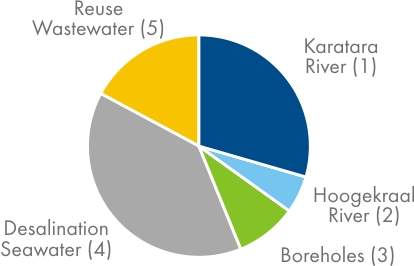
Figure 4: Distribution of Cost of Water from Sources
Project budget & programme

Notes:
1 Estimates are based on preliminary costing
2 Estimated costs reflect present value and exclude escalation.
3 The escalation can be covered by Knysna Municipality's contribution
4 Professional fees, site monitoring, investigations and disbursement costs are included
5 The Environmental and Water Licensing authorizations are to be obtained
Project implementation programme
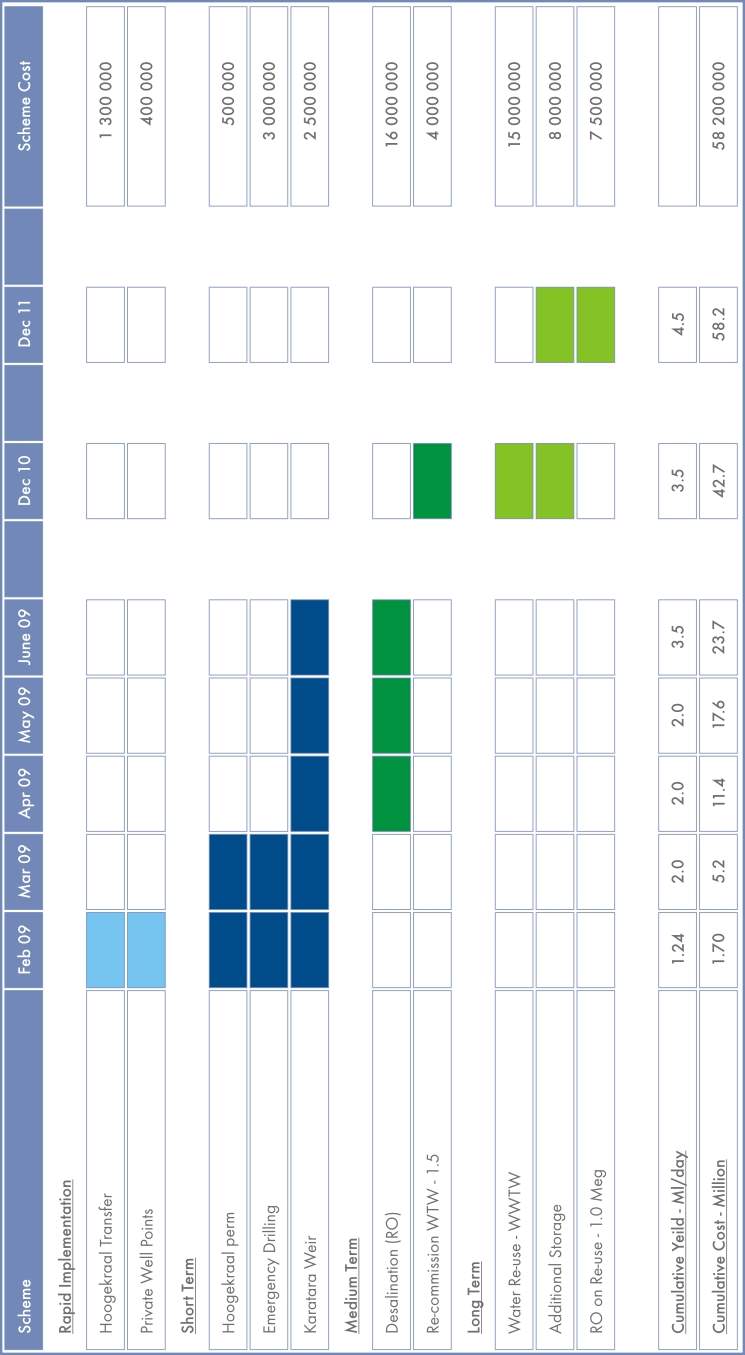
Conclusion
An innovative, demand-based approach was developed to address the water supply crisis in Sedgefield, and this proved to be cost effective and achievable within the tight time constrains.
The Sedgefield projects was the forerunner coining the phrase “ Conjunctive Water Use “ and paved the way for Mossel Bay, George, Knynsa and Plettenberg Bay to re-asses all available water sources. “New Water” was now mandatory in the water portfolios of the municipalities to limit the risk of complete failure once our rivers run dry.
The approach was based on making better use of the available water resources and to supplement the traditional, inexpensive supply sources with ground water, desalinated water and the re-use of final effluent. The conjunctive supply approach limits the risk of supply failure from a single source, and ensures sustainable potable water security for Sedgefield into the future.
There is indeed “Life beyond our rivers “ in the Garden Route.